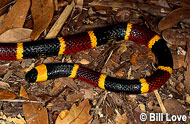Description:
Three species of coral snakes are the only elapine snakes native to the United States. The age old ditty “red to yellow kill a fellow, red to black, venom lack†works well for identifying the coral snakes of the United States—except on Key Largo, Florida where most or all of the yellow pigment is absent. Another way of remembering the color sequence of the coral snake (again, except on Key Largo) is to remember that like a traffic signal where the two caution colors, red and yellow, are next to each other, the two caution colors touch on the coral snake. On the harmless “mimics†the caution colors are separated by black. Two erroneous beliefs must be dispelled. Firstly, the dangerously venomous coral snake is not a rear-fanged snake. It is a front-fanged species. The fangs are short and do not rotate on a movable maxillary bone like a vipers fangs do. And secondly a coral snake can and will bite anywhere they can reach. It is NOT true that they can bite only on finger or toe. A coral snake does not administer venom as effectively as a viper, but it is a very dangerous snake that should be treated with caution and respect. The eastern coral snake is so secretive that it might actually be present in an area in fair numbers yet its existence may be unsuspected. This taxon is one of the more difficult snakes to maintain successfully as captive. In addition to pieces of flat bark beneath which they may hide, they should be given a substrate of several inches of finely shredded cypress mulch, peat moss or pelleted newsprint into which they may burrow. It may be beneficial to keep a small area of the substrate barely moistened and the rest dry. The terrarium in which a coral snake is kept can be low but must be escape proof and should have a fairly large footprint—24 inches by 48 inches is suggested. A low-edged water bowl sufficiently large for the snake to both drink and soak should be provided. The water must be kept fresh and clean. Daytime illumination is not needed. A temperature gradient can be maintained by placing a small undertank heater on one end of the terrarium. The temperature on the hot end of the terrarium should be about 82 degrees Fahrenheit; the cool end should be in the 70s. Nighttime temperatures can drop into the high 60s. Coral snakes should be disturbed as little as possible. Some coral snakes will balance quietly on a snakehook, but most will not. It is fairly easy to shepherd a coral snake into a large jar or other receptacle that can be securely covered while the snake is being moved. The use of a clampstick is contraindicated for the amount of pressure needed to ascertain that a writhing coral snake does not slip free from the clamp may be enough to actually injure the snake. Eastern coral snakes will accept many snake species including burrowing snakes, baby racers, green snakes, hatchling corn snakes, glass lizards and an and occasional skink as prey. A very few coral snakes can be acclimated to accepting pinky mice that have been scented with a snake, glass lizards or skinks. Although some keepers have fed captive coral snakes frozen then thawed ring-necked snakes with regularity, other experienced keepers argue that ring-necks, live or dead, can be fatal to a coral snake that eats them. Eastern coral snakes usually have from 2 to 7 (rarely to 12) eggs. The hatchlings are between 7 and 9 inches in length.
Habitat:
This snake prefers a substrate into which it can easily burrow. Pine-oak-palmetto scrub, hammocks, pond edges and even suburban yards and gardens are all suitable habitats.
Range:
A species predominantly of the southeastern Coastal Plain and lower Piedmont from central North Carolina to extreme eastern Louisiana. It is found throughout mainland Florida and the Upper Florida Keys.
Scientific Name: Micrurus fulvius
Species Group: venomous
Family: Elapidae
Size: This very secretive snake commonly attains 2½ feet in length. The record authenticated size is 47½ inches.
Level: advanced
Weight:
Dangerous: Yes


